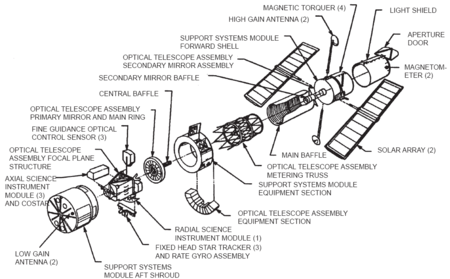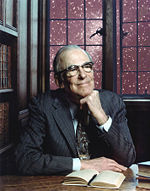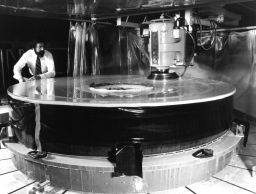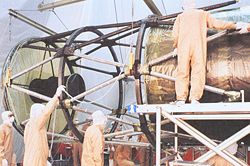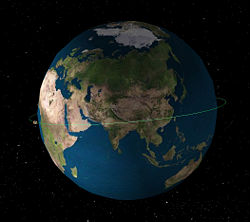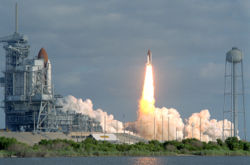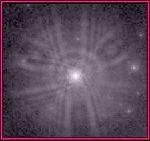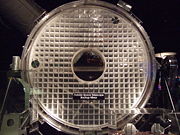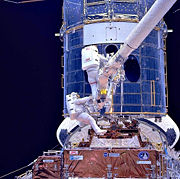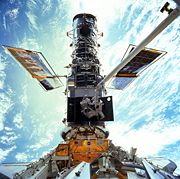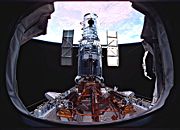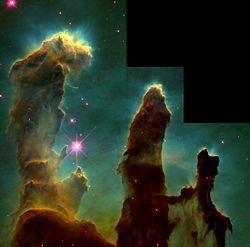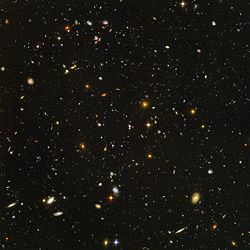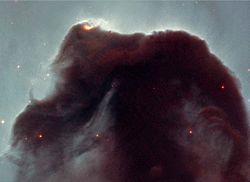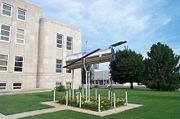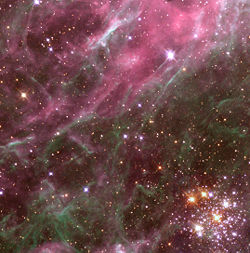Hubble Space Telescope
2008/9 Schools Wikipedia Selection. Related subjects: Space transport
| Hubble Space Telescope (HST) | |
|---|---|
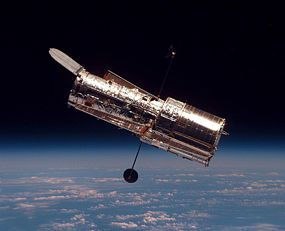 The Hubble Space Telescope as seen from Space Shuttle Discovery during its second servicing mission ( STS-82)
|
|
| General information | |
| NSSDC ID | 1990-037B |
| Organization | NASA / ESA / STScI |
| Launch date | April 24, 1990 |
| Deorbited | Likely between 2013 and 2021 |
| Mass | 11,110 kg (24,250 lb) |
| Type of orbit | Near-circular low Earth orbit |
| Orbit height | 589 km (366 mi) |
| Orbit period | 96–97 min |
| Orbit velocity | 7,500 m/s (17,000 mph) |
| Acceleration due to gravity | 8.169 m/s² (26.80 ft/s²) |
| Location | Low Earth orbit |
| Telescope style | Ritchey-Chretien reflector |
| Wavelength | Optical, ultraviolet, near-infrared |
| Diameter | 2.4 m (94 in) |
| Collecting area | approx. 4.5 m² (46 ft²) |
| Focal length | 57.6 m (189 ft) |
| Instruments | |
| NICMOS | infrared camera/spectrometer |
| ACS | optical survey camera (mostly failed) |
| WFPC2 | wide field optical camera |
| STIS | optical spectrometer/camera (failed) |
| FGS | three fine guidance sensors |
| Website http://www.nasa.gov/hubble · http://hubble.nasa.gov http://hubblesite.org · http://www.spacetelescope.org |
|
The Hubble Space Telescope (HST; also known colloquially as "the Hubble" or just "Hubble") is a space telescope that was carried into orbit by a Space Shuttle in April 1990. It is named for the American astronomer, Edwin Hubble. Although not the first space telescope, the Hubble is one of the largest and most versatile, and is well known as both a vital research tool and a public relations boon for astronomy. The HST is a collaboration between NASA and the European Space Agency, and is one of NASA's Great Observatories, along with the Compton Gamma Ray Observatory, the Chandra X-ray Observatory, and the Spitzer Space Telescope.
Space telescopes were proposed as early as the 1940s. The Hubble was funded in the 1970s, with a proposed launch in 1983, but the project was beset by technical delays, budget problems, and the Challenger disaster. When finally launched in 1990, scientists found that the main mirror had been ground incorrectly, severely compromising the telescope's capabilities. However, after a servicing mission in 1993, the telescope was restored to its intended quality. Hubble's position outside the Earth's atmosphere allows it to take extremely sharp images with almost no background light. Hubble's Ultra Deep Field image, for instance, is the most detailed visible-light image of the universe's most distant objects ever made. Many Hubble observations have led to breakthroughs in astrophysics, such as accurately determining the rate of expansion of the universe.
The Hubble is the only telescope ever designed to be serviced in space by astronauts. To date, there have been four servicing missions. Servicing Mission 1 took place in December 1993 when Hubble's imaging flaw was corrected. Servicing missions 2, 3, and 4 repaired various sub-systems and replaced many of the observing instruments with more modern and capable versions. However, following the 2003 Columbia Space Shuttle disaster, the fifth servicing mission was canceled on safety grounds. After spirited public discussion, NASA reconsidered this decision, and administrator Mike Griffin gave the green light for one final Hubble servicing mission. This is now planned for October 2008.
The planned repairs to the Hubble will allow the telescope to function until at least 2013, when its successor, the James Webb Space Telescope (JWST), is due to be launched. The JWST will be far superior to Hubble for many astronomical research programs, but will only observe in infrared, so it would complement (not replace) Hubble's ability to observe in the visible and ultraviolet parts of the spectrum.
Conception, design and aims
Proposals and precursors
In 1923, German scientist Hermann Oberth, considered one of the three fathers of modern rocketry along with Robert Goddard and Konstantin Tsiolkovsky, published "Die Rakete zu den Planetenräumen" ("The Rocket into Planetary Space"), which mentioned how a telescope could be propelled into Earth orbit by a rocket.
The history of the Hubble Space Telescope can be traced back as far as 1946, when the astronomer Lyman Spitzer wrote the paper "Astronomical advantages of an extraterrestrial observatory". In it, he discussed the two main advantages that a space-based observatory would have over ground-based telescopes. First, the angular resolution (smallest separation at which objects can be clearly distinguished) would be limited only by diffraction, rather than by the turbulence in the atmosphere, which causes stars to twinkle and is known to astronomers as seeing. At that time ground-based telescopes were limited to resolutions of 0.5–1.0 arcseconds, compared to a theoretical diffraction-limited resolution of about 0.05 arcsec for a telescope with a mirror 2.5 m in diameter. Second, a space-based telescope could observe infrared and ultraviolet light, which are strongly absorbed by the atmosphere.
Spitzer devoted much of his career to pushing for a space telescope to be developed. In 1962 a report by the United States National Academy of Sciences recommended the development of a space telescope as part of the space program, and in 1965 Spitzer was appointed as head of a committee given the task of defining the scientific objectives for a large space telescope.
Space-based astronomy had begun on a very small scale following World War II, as scientists made use of developments that had taken place in rocket technology. The first ultraviolet spectrum of the Sun was obtained in 1946. An orbiting solar telescope was launched in 1962 by the United Kingdom as part of the Ariel space program, and in 1966 National Aeronautics and Space Administration (NASA) launched the first Orbiting Astronomical Observatory (OAO) mission. OAO-1's battery failed after three days, terminating the mission. It was followed by OAO-2, which carried out ultraviolet observations of stars and galaxies from its launch in 1968 until 1972, well beyond its original planned lifetime of one year.
The OAO missions demonstrated the important role space-based observations could play in astronomy, and 1968 saw the development by NASA of firm plans for a space-based reflecting telescope with a mirror 3 m in diameter, known provisionally as the Large Orbiting Telescope or Large Space Telescope (LST), with a launch slated for 1979. These plans emphasized the need for manned maintenance missions to the telescope to ensure such a costly program had a lengthy working life, and the concurrent development of plans for the reusable Space Shuttle indicated that the technology to allow this was soon to become available.
Quest for funding
The continuing success of the OAO program encouraged increasingly strong consensus within the astronomical community that the LST should be a major goal. In 1970 NASA established two committees, one to plan the engineering side of the space telescope project, and the other to determine the scientific goals of the mission. Once these had been established, the next hurdle for NASA was to obtain funding for the instrument, which would be far more costly than any Earth-based telescope. The US Congress questioned many aspects of the proposed budget for the telescope and forced cuts in the budget for the planning stages, which at the time consisted of very detailed studies of potential instruments and hardware for the telescope. In 1974, public spending cuts instigated by Gerald Ford led to Congress cutting all funding for the telescope project.
In response to this, a nationwide lobbying effort was coordinated among astronomers. Many astronomers met congressmen and senators in person, and large scale letter-writing campaigns were organized. The National Academy of Sciences published a report emphasizing the need for a space telescope, and eventually the Senate agreed to half of the budget that had originally been approved by Congress.
The funding issues led to something of a reduction in the scale of the project, with the proposed mirror diameter reduced from 3 m to 2.4 m, both to cut costs and to allow a more compact and effective configuration for the telescope hardware. A proposed precursor 1.5 m space telescope to test the systems to be used on the main satellite was dropped, and budgetary concerns also prompted collaboration with the European Space Agency. ESA agreed to provide funding and supply one of the first generation instruments for the telescope, as well as the solar cells that would power it, and staff to work on the telescope in the United States, in return for European astronomers being guaranteed at least 15% of the observing time on the telescope. Congress eventually approved funding of US$36,000,000 for 1978, and the design of the LST began in earnest, aiming for a launch date of 1983. In 1983 the telescope was named after Edwin Hubble, who made one of the greatest scientific breakthroughs of the 20th century when he discovered that the universe was expanding.
Construction and engineering
Once the Space Telescope project had been given the go-ahead, work on the program was divided among many institutions. Marshall Space Flight Centre (MSFC) was given responsibility for the design, development, and construction of the telescope, while the Goddard Space Flight Centre was given overall control of the scientific instruments and ground-control centre for the mission. MSFC commissioned the optics company Perkin-Elmer to design and build the Optical Telescope Assembly (OTA) and Fine Guidance Sensors for the space telescope. Lockheed was commissioned to construct the spacecraft in which the telescope would be housed.
Optical Telescope Assembly (OTA)
The mirror and optical systems of the telescope were the most crucial and complex part, and were designed to exacting specifications. Optical telescopes typically have mirrors polished to an accuracy of about a tenth of the wavelength of visible light, but the Space Telescope was to be used for observations into the ultraviolet (shorter wavelengths) and was specified to be diffraction limited to take full advantage of the space environment. Therefore its mirror needed to be polished to an accuracy of 10 nanometres, or about 1/65 of the wavelength of red light.
Perkin-Elmer intended to use extremely sophisticated computer-controlled polishing machines to grind the mirror to the required shape, but in case their cutting-edge technology ran into difficulties, NASA demanded that PE sub-contract to Kodak to construct a back-up mirror using traditional mirror-polishing techniques. (The team of Kodak and Itek also bid on the original mirror polishing work. Their bid called for the two companies to double-check each other's work, which would have almost certainly caught the polishing error that later caused such problems.) The Kodak mirror is now on permanent display at the Smithsonian Institution.. An Itek mirror built as part of the effort is now used in the 2.4 m telescope at the Magdalena Ridge Observatory.
Construction of the Perkin-Elmer mirror began in 1979, using ultra-low expansion glass. To keep the mirror's weight to a minimum it consisted of inch-thick top and bottom plates sandwiching a honeycomb lattice. Mirror polishing continued until May 1981. NASA reports at the time questioned Perkin-Elmer's managerial structure, and the polishing began to slip behind schedule and over budget. To save money, NASA halted work on the back-up mirror and put the launch date of the telescope back to October 1984. The mirror was completed by the end of 1981 with the addition of a reflective coating of aluminium 65 nm thick and a protective coating of magnesium fluoride 25 nm thick.
Doubts continued to be expressed about Perkin-Elmer's competence on a project of this importance as their budget and timescale for producing the rest of the OTA continued to inflate. In response to a schedule described as "unsettled and changing daily", NASA postponed the launch date of the telescope until April 1985. Perkin-Elmer's schedules continued to slip at a rate of about one month per quarter, and at times delays reached one day for each day of work. NASA was forced to postpone the launch date until first March and then September 1986. By this time the total project budget had risen to US$1.175 billion.
Spacecraft systems
The spacecraft in which the telescope and instruments were to be housed was another major engineering challenge. It would have to adequately withstand frequent passages from direct sunlight into the darkness of Earth's shadow, which would generate major changes in temperature, while being stable enough to allow extremely accurate pointing of the telescope. A shroud of multi-layer insulation keeps the temperature within the telescope stable, and surrounds a light aluminium shell in which the telescope and instruments sit. Within the shell, a graphite-epoxy frame keeps the working parts of the telescope firmly aligned.
While construction of the spacecraft in which the telescope and instruments would be housed proceeded somewhat more smoothly than the construction of the OTA, Lockheed still experienced some budget and schedule slippage, and by the summer of 1985, construction of the spacecraft was 30% over budget and three months behind schedule. An MSFC report said that Lockheed tended to rely on NASA directions rather than take their own initiative in the construction.
Initial instruments
When launched, the HST carried five scientific instruments: the Wide Field and Planetary Camera (WF/PC), Goddard High Resolution Spectrograph (GHRS), High Speed Photometer (HSP), Faint Object Camera (FOC) and the Faint Object Spectrograph (FOS). WF/PC was a high-resolution imaging device primarily intended for optical observations. It was built by NASA's Jet Propulsion Laboratory, and incorporated a set of 48 filters isolating spectral lines of particular astrophysical interest. The instrument contained eight CCD chips divided between two cameras, each using four CCDs. The "wide field camera" (WFC) covered an angularly large field at the expense of resolution, while the "planetary camera" (PC) took images at a longer effective focal length than the WF chips, giving it a greater magnification.
The GHRS was a spectrograph designed to operate in the ultraviolet. It was built by the Goddard Space Flight Centre and could achieve a spectral resolution of 90,000. Also optimized for ultraviolet observations were the FOC and FOS, which were capable of the highest spatial resolution of any instruments on Hubble. Rather than CCDs these three instruments used photon-counting digicons as their detectors. FOC was constructed by ESA, while the Martin Marietta corporation built the FOS.
The final instrument was the HSP, designed and built at the University of Wisconsin–Madison. It was optimized for visible and ultraviolet light observations of variable stars and other astronomical objects varying in brightness. It could take up to 100,000 measurements per second with a photometric accuracy of about 2% or better.
HST's guidance system can also be used as a scientific instrument. Its three Fine Guidance Sensors (FGS) are primarily used to keep the telescope accurately pointed during an observation, but can also be used to carry out extremely accurate astrometry; measurements accurate to within 0.0003 arcseconds have been achieved.
Ground support
The Space Telescope Science Institute (STScI) is responsible for the scientific operation of the telescope and delivery of data products to astronomers. STScI is operated by the Association of Universities for Research in Astronomy (AURA) and is physically located in Baltimore, Maryland on the Homewood campus of Johns Hopkins University, one of the 33 US universities and 7 international affiliates that make up the AURA consortium. STScI was established in 1983 after something of a power struggle between NASA and the scientific community at large. NASA had wanted to keep this function "in-house", but scientists wanted it to be based in an academic establishment. The Space Telescope European Coordinating Facility (ST-ECF), established at Garching bei München near Munich in 1984, provides similar support for European astronomers.
One rather complex task that falls to STScI is scheduling observations for the telescope. Hubble is situated in a low-Earth orbit so that it can be reached by the Space Shuttle for servicing missions, but this means that most astronomical targets are occulted by the Earth for slightly less than half of each orbit. Observations cannot take place when the telescope passes through the South Atlantic Anomaly due to elevated radiation levels, and there are also sizable exclusion zones around the Sun (precluding observations of Mercury), Moon and Earth. The solar avoidance angle is about 50°, which is specified to keep sunlight from illuminating any part of the OTA. Earth and Moon avoidance is to keep bright light out of the FGSs and to keep scattered light from entering the instruments. If the FGSs are turned off, however, the Moon and Earth can be observed. Earth observations were used very early in the program to generate flat-fields for the WFPC1 instrument. There is a so-called continuous viewing zone (CVZ), at roughly 90 degrees to the plane of Hubble's orbit, in which targets are not occulted for long periods. Due to the precession of the orbit, the location of the CVZ moves slowly over a period of eight weeks. Because the limb of the Earth is always within about 30° of regions within the CVZ, the brightness of scattered earthshine may be elevated for long periods during CVZ observations.
Because Hubble orbits in the upper atmosphere, its orbit changes over time in a way that is not accurately predictable. The density of the upper atmosphere varies according to many factors, and this means that Hubble's predicted position for six weeks' time could be in error by up to 4,000 km. Observation schedules are typically finalized only a few days in advance, as a longer lead time would mean there was a chance that the target would be unobservable by the time it was due to be observed.
Engineering support for the Hubble is provided by NASA and contractor personnel at the Goddard Space Flight Centre in Greenbelt, Maryland, 48 km south of the STScI. Hubble's operation is monitored 24 hours per day by four teams of flight controllers who make up Hubble's Flight Operations Team.
Challenger disaster, delays, and eventual launch
In early 1986, the planned launch date of October that year looked feasible, but the Challenger disaster brought the US space program to a halt, grounding the Space Shuttle fleet and forcing the launch of Hubble to be postponed for several years. The telescope had to be kept in a clean room, powered up and purged with nitrogen, until a launch could be rescheduled. This costly situation (about $6 million per month) pushed the overall costs of the project even higher. On the other hand, engineers used this time to perform extensive tests, swap out a possible failure prone battery, and make other improvements.
Eventually, following the resumption of shuttle flights in 1988, the launch of the telescope was scheduled for 1990. On 24 April 1990, shuttle mission STS-31 saw Discovery launch the telescope successfully into its planned orbit.
From its original total cost estimate of about US$400 million, the telescope had by now cost over $2.5 billion to construct. Hubble's cumulative costs up to this day are estimated to be several times higher still, with US expenditure estimated at between $4.5 and $6 billion, and Europe's financial contribution at €593 million (1999 estimate).
Flawed mirror
Within weeks of the launch of the telescope, the images returned showed that there was a serious problem with the optical system. Although the first images appeared to be sharper than ground-based images, the telescope failed to achieve a final sharp focus, and the best image quality obtained was drastically lower than expected. Images of point sources spread out over a radius of more than one arcsecond, instead of having a point spread function concentrated within a circle 0.1 arcsec in diameter as had been specified in the design criteria. The detailed performance is shown in graphs from STScI illustrating the mis- figured PSFs compared to post-correction and ground based PSFs.
Analysis of the flawed images showed that the cause of the problem was that the primary mirror had been ground to the wrong shape. Although it was probably the most precisely figured mirror ever made, with variations from the prescribed curve of no more than 1/65 of the wavelength of visible light, it was too flat at the edges. The mirror was barely 2.3 micrometres out from the required shape, but the difference was catastrophic, introducing severe spherical aberration, a flaw in which light reflecting off the edge of a mirror focuses on a different point from the light reflecting off its centre.
The effect of the mirror flaw on scientific observations depended on the particular observation—the core of the aberrated PSF was sharp enough to permit uniquely high-resolution observations of bright objects, and spectroscopy was largely unaffected. However, the loss of light to the large, out of focus halo severely reduced the usefulness of the telescope for faint objects or high contrast imaging. This meant that nearly all of the cosmological programs were essentially impossible since they required observation of exceptionally faint objects. NASA and the telescope became the butt of many jokes, and the project was popularly regarded as a white elephant. (For instance, in the movie The Naked Gun 2½: The Smell of Fear, the Hubble was pictured with the Titanic, the Hindenburg, and the Edsel). Nonetheless, during the first three years of the Hubble mission, before the optical corrections, the telescope still carried out a large number of productive observations. The error was well characterized and stable, enabling astronomers to optimize the results obtained using sophisticated image processing techniques such as deconvolution.
Origin of the problem
A commission headed by Lew Allen, director of the Jet Propulsion Laboratory, was established to determine how the error could have arisen. The Allen Commission found that the main null corrector, a device used to measure the exact shape of the mirror, had been incorrectly assembled—one lens was wrongly spaced by 1.3 mm. During the polishing of the mirror, Perkin-Elmer had analyzed its surface with two other null correctors, both of which (correctly) indicated that the mirror was suffering from spherical aberration. The company ignored these test results as it believed that the two null correctors were less accurate than the primary device which was reporting that the mirror was perfectly figured.
The commission blamed the failings primarily on Perkin-Elmer. Relations between NASA and the optics company had been severely strained during the telescope construction due to frequent schedule slippage and cost overruns. NASA found that Perkin-Elmer had not regarded the telescope mirror as a crucial part of their business and were also secure in the knowledge that NASA could not take its business elsewhere once the polishing had begun. While the commission heavily criticized Perkin-Elmer for these managerial failings, NASA was also criticized for not picking up on the quality control shortcomings such as relying totally on test results from a single instrument.
Design of a solution
The design of the telescope had always incorporated servicing missions, and astronomers immediately began to seek potential solutions to the problem which could be applied at the first servicing mission, scheduled for 1993. While Kodak and Itek had each ground back-up mirrors for Hubble, it would have been impossible to replace the mirror in orbit, and too expensive and time-consuming to bring the telescope temporarily back to Earth for a refit. Instead, the fact that the mirror had been ground so precisely to the wrong shape led to the design of new optical components with exactly the same error but in the opposite sense, to be added to the telescope at the servicing mission, effectively acting as "spectacles" to correct the spherical aberration.
The first step was a precise characterization of the error in the main mirror. Working backwards from images of point sources, astronomers determined that the conic constant of the mirror was −1.01324, instead of the intended −1.00230. The same number was also derived by analyzing the null corrector used by Perkin-Elmer to figure the mirror, as well as by analyzing interferograms obtained during ground testing of the mirror.
Because of the way the instruments were designed, two different sets of correctors were required. The design of the Wide Field and Planetary Camera 2, already planned to replace the existing WF/PC, included relay mirrors to direct light onto the eight separate CCD chips making up its two cameras. An inverse error built into their surfaces could completely cancel the aberration of the primary. However, the other instruments lacked any intermediate surfaces which could be figured in this way, and so required an external correction device.
The system designed to correct the spherical aberration for light focused at the FOC, FOS, and GHRS was called the "Corrective Optics Space Telescope Axial Replacement" ( COSTAR) and consisted essentially of two mirrors in the light path, one of which would be figured to correct the aberration. To fit the COSTAR system onto the telescope, one of the other instruments had to be removed, and astronomers selected the High Speed Photometer to be sacrificed.
Servicing missions and new instruments
Servicing Mission 1
The telescope had always been designed so that it could be regularly serviced, but after the problems with the mirror came to light, the first servicing mission assumed a much greater importance, as the astronauts would have to carry out extensive work on the telescope to install the corrective optics. The seven astronauts selected for the mission were trained intensively in the use of the hundred or so specialized tools which would need to be used. The mission STS-61 of the Space Shuttle Endeavour took place in December 1993, and involved installation of several instruments and other equipment over a total of 10 days.
Most importantly, the High Speed Photometer was replaced with the COSTAR corrective optics package, and WFPC was replaced with the Wide Field and Planetary Camera 2 (WFPC2) with its internal optical correction system. In addition, the solar arrays and their drive electronics were replaced, as well as four of the gyroscopes used in the telescope pointing system, two electrical control units and other electrical components, and two magnetometers. The onboard computers were upgraded, and finally, the telescope's orbit was boosted, to compensate for the orbital decay from 3 years of drag in the tenuous upper atmosphere.
On January 13, 1994, NASA declared the mission a complete success and showed the first of many much sharper images. The mission had been one of the most complex ever undertaken, involving five lengthy periods of extravehicular activity and its resounding success was an enormous boon for NASA, as well as for the astronomers who now had a fully capable space telescope.
Servicing Mission 2
Servicing Mission 2 Discovery ( STS-82) in February 1997 replaced the GHRS and the FOS with the Space Telescope Imaging Spectrograph (STIS) and the Near Infrared Camera and Multi-Object Spectrometer (NICMOS), replaced an Engineering and Science Tape Recorder with a new Solid State Recorder, repaired thermal insulation and again boosted Hubble's orbit. NICMOS contained a heat sink of solid nitrogen to reduce the thermal noise from the instrument, but shortly after it was installed, an unexpected thermal expansion resulted in part of the heat sink coming into contact with an optical baffle. This led to an increased warming rate for the instrument and reduced its original expected lifetime of 4.5 years to about 2 years.
Servicing Mission 3A
Servicing Mission 3A Discovery ( STS-103) took place in December 1999, split off from Servicing Mission 3 after three of the six onboard gyroscopes had failed. (A fourth failed a few weeks before the mission, rendering the telescope incapable of performing science observations.) The mission replaced all six gyroscopes, replaced a Fine Guidance Sensor and the computer, installed a Voltage/temperature Improvement Kit (VIK) to prevent battery overcharging, and replaced thermal insulation blankets. Although the new computer is hardly a powerhouse (a 25 MHz radiation hardened Intel 486 with two megabytes of RAM), it is still 20 times faster, with six times more memory, than the DF-224 it replaced. The new computer increases throughput by moving some computing tasks from the ground to the spacecraft, and saves money by allowing the use of modern programming languages.
Servicing Mission 3B
Servicing Mission 3B Columbia ( STS-109) in March 2002 saw the installation of a new instrument, with the FOC being replaced by the Advanced Camera for Surveys (ACS). It also saw the revival of NICMOS, which had run out of coolant in 1999. A new cooling system was installed which reduced the instrument's temperature enough for it to be usable again. Although not as cold as its original design called for, the temperature is more stable, in many ways a better tradeoff.. ACS in particular enhanced the Hubble's capabilities; it and the revived NICMOS together imaged the Hubble Ultra Deep Field.
The mission replaced the solar arrays for the second time. The new arrays were derived from those built for the Iridium comsat system and were only two-thirds the size of the old arrays, resulting in less drag against the tenuous reaches of the upper atmosphere while providing 30 percent more power. The additional power allowed all instruments on board the Hubble to be run simultaneously, and reduced a vibration problem that occurred when the old, less rigid arrays entered and left direct sunlight. Hubble's Power Distribution Unit was also replaced in order to correct a problem with sticky relays, a procedure that required the complete electrical power down of the spacecraft for the first time since it was launched.
Scientific results
Important discoveries
Hubble has helped to resolve some long-standing problems in astronomy, as well as turning up results that have required new theories to explain them. Among its primary mission targets was to measure distances to Cepheid variable stars more accurately than ever before, and thus constrain the value of the Hubble constant, the measure of the rate at which the universe is expanding, which is also related to its age. Before the launch of HST, estimates of the Hubble constant typically had errors of up to 50%, but Hubble measurements of Cepheid variables in the Virgo Cluster and other distant galaxy clusters provided a measured value with an accuracy of 10%, which is consistent with other more accurate measurements made since Hubble's launch using other techniques.
While Hubble helped to refine estimates of the age of the universe, it also cast doubt on theories about its future. Astronomers from the High-z Supernova Search Team and the Supernova Cosmology Project used the telescope to observe distant supernovae and uncovered evidence that, far from decelerating under the influence of gravity, the expansion of the universe may in fact be accelerating. This acceleration was later measured more accurately by other ground-based and space-based telescopes which confirmed Hubble's finding, but the cause of this acceleration is currently very poorly understood.
The high-resolution spectra and images provided by the Hubble have been especially well-suited to establishing the prevalence of black holes in the nuclei of nearby galaxies. While it had been hypothesized in the early 1960s that black holes would be found at the centers of some galaxies, and work in the 1980s identified a number of good black hole candidates, it fell to work conducted with the Hubble to show that black holes are probably common to the centers of all galaxies. The Hubble programs further established that the masses of the nuclear black holes and properties of the galaxies are closely related. The legacy of the Hubble programs on black holes in galaxies is thus to demonstrate a deep and profound connection between galaxies and their central black holes.
The collision of Comet Shoemaker-Levy 9 with Jupiter in 1994 was fortuitously timed for astronomers, coming just a few months after Servicing Mission 1 had restored Hubble's optical performance. Hubble images of the planet were sharper than any taken since the passage of Voyager 2 in 1979, and were crucial in studying the dynamics of the collision of a comet with Jupiter, an event believed to occur once every few centuries.
Other major discoveries made using Hubble data include proto-planetary disks ( proplyds) in the Orion Nebula; evidence for the presence of extrasolar planets around sun-like stars; and the optical counterparts of the still-mysterious gamma ray bursts. HST has also been used to study objects in the outer reaches of the Solar System, including the dwarf planets Pluto and Eris.
A unique legacy of Hubble is Hubble Deep Field and Hubble Ultra Deep Field images, which utilized Hubble's unmatched sensitivity at visible wavelengths to create images of small patches of sky which are the deepest ever obtained at optical wavelengths. The images reveal galaxies billions of light years away, and have generated a wealth of scientific papers, providing a new window on the early Universe.
Impact on astronomy
Many objective measures show the positive impact of Hubble data on astronomy. Over 4,000 papers based on Hubble data have been published in peer-reviewed journals, and countless more have appeared in conference proceedings. Looking at papers several years after their publication, about one-third of all astronomy papers have no citations, while only 2% of papers based on Hubble data have no citations. On average, a paper based on Hubble data receives about twice as many citations as papers based on non-Hubble data. Of the 200 papers published each year which receive the most citations, about 10% are based on Hubble data.
Although the HST has clearly had a significant impact on astronomical research, the financial cost of this impact has been large. A study on the relative impacts on astronomy of different sizes of telescopes found that while papers based on HST data generate 15 times as many citations as a 4 m ground-based telescope such as the William Herschel Telescope, the HST costs about 100 times as much to build and maintain.
Making the decision between investing in ground-based versus space-based telescopes in the future is complex. Advances in adaptive optics have extended the high-resolution imaging capabilities of ground-based telescopes to the infrared imaging of faint objects. The usefulness of adaptive optics versus HST observations depends strongly on the particular details of the research questions being asked. In the visible bands, adaptive optics can only correct a relatively small field of view, whereas HST can conduct high-resolution optical imaging over a wide field. Even before Hubble's launch, ground-based speckle imaging could provide higher resolution images of bright objects than Hubble can achieve, but Hubble's high resolution extends to dim objects as well.
Using the telescope
Anyone can apply for time on the telescope; there are no restrictions on nationality or academic affiliation. Competition for time on the telescope is extremely intense, and the ratio of time requested to time available (the oversubscription ratio) typically ranges between 6 and 9.
Calls for proposals are issued roughly annually, with time allocated for a cycle lasting approximately one year. Proposals are divided into several categories; 'general observer' proposals are the most common, covering routine observations. 'Snapshot observations' are those in which targets require only 45 minutes or less of telescope time, including overheads such as acquiring the target; snapshot observations are used to fill in gaps in the telescope schedule which cannot be filled by regular GO programs.
Astronomers may make 'Target of Opportunity' proposals, in which observations are scheduled if a transient event covered by the proposal occurs during the scheduling cycle. In addition, up to 10% of the telescope time is designated Director's Discretionary (DD) Time. Astronomers can apply to use DD time at any time of year, and it is typically awarded for study of unexpected transient phenomena such as supernovae. Other uses of DD time have included the observations that led to the production of the Hubble Deep Field and Hubble Ultra Deep Field, and in the first four cycles of telescope time, observations carried out by amateur astronomers.
Amateur observations
The first director of STScI, Riccardo Giacconi, announced in 1986 that he intended to devote some of his Director Discretionary time to allowing amateur astronomers to use the telescope. The total time to be allocated was only a few hours per cycle, but excited great interest among amateur astronomers.
Proposals for amateur time were stringently peer reviewed by a committee of leading amateur astronomers, and time was awarded only to proposals that were deemed to have genuine scientific merit, did not duplicate proposals made by professionals, and required the unique capabilities of the space telescope. In total, 13 amateur astronomers were awarded time on the telescope, with observations being carried out between 1990 and 1997. One such study was Transition Comets -- UV Search for OH Emissions in Asteroids. After that time, however, budget reductions at STScI made the support of work by amateur astronomers untenable, and no further amateur programs have been carried out.
Hubble data
Transmission to Earth
Hubble data were initially stored on the spacecraft. When launched, the storage facilities were old-fashioned reel-to-reel tape recorders, but these were replaced by solid state data storage facilities during servicing missions 2 and 3A. From the onboard storage facilities, data are transferred to the ground via the Tracking and Data Relay Satellite System, a system of satellites designed so that satellites in low-Earth orbit can communicate with their mission control facilities during about 85% of their orbit. Data are transmitted to the TDRSS ground station and then on to the Goddard Space Flight Centre and finally to the Space Telescope Science Institute for archiving.
Archive
All Hubble data are eventually made available via the archives of STScI.. Data are usually proprietary—available only to the principal investigator (PI) and astronomers designated by the PI—for one year after being taken. The PI can apply to the director of the STScI to extend or reduce the proprietary period in some circumstances.
Observations made on Director's Discretionary Time are exempt from the proprietary period, and are released to the public immediately. Calibration data such as flat fields and dark frames are also publicly available straight away. All data in the archive are in the FITS format, which is suitable for astronomical analysis but not for public use. The Hubble Heritage Project processes and releases to the public a small selection of the most striking images in JPEG and TIFF formats.
Pipeline reduction
Astronomical data taken with CCDs must undergo several calibration steps before it is suitable for astronomical analysis. STScI has developed sophisticated software which automatically calibrates data when it is requested from the archive using the best calibration files available. This 'on-the-fly' processing means that large data requests can take a day or more to be processed and returned. The process by which data is calibrated automatically is known as 'pipeline reduction', and is increasingly common at major observatories. Astronomers may if they wish retrieve the calibration files themselves and run the pipeline reduction software locally. This may be desirable when calibration files other than those selected automatically need to be used.
Data analysis
Hubble data can be analysed using many different packages. STScI maintains the custom-made STSDAS (Space Telescope Science Data Analysis System) software, which contains all the programs needed to run pipeline reduction on raw data files, as well as many other astronomical image processing tools, tailored to the requirements of Hubble data. The software runs as a module of IRAF, a popular astronomical data reduction program.
Outreach activities
It has always been important for the Space Telescope to capture the public's imagination, given the considerable contribution of taxpayers to its construction and operational costs. After the difficult early years when the faulty mirror severely dented Hubble's reputation with the public, the first servicing mission allowed its rehabilitation as the corrected optics produced numerous remarkable images.
Several initiatives have helped to keep the public informed about Hubble activities. The Hubble Heritage Project was established to produce high-quality images for public consumption of the most interesting and striking objects observed. The Heritage team is composed of amateur and professional astronomers, as well as people with backgrounds outside astronomy, and emphasizes the aesthetic nature of Hubble images. The Heritage Project is granted a small amount of time to observe objects which, for scientific reasons, may not have images taken at enough wavelengths to construct a full-colour image.
In addition, STScI maintains several comprehensive websites for the general public containing Hubble images and information about the observatory. The outreach efforts are coordinated by the Office for Public Outreach, which was established in 2000 to ensure that US taxpayers saw the benefits of their investment in the space telescope program.
Since 1999, the leading Hubble outreach activities group in Europe has been the Hubble European Space Agency Information Centre (HEIC). This office was established at the Space Telescope - European Coordinating Facility (ST-ECF) in Munich, Germany. HEIC's mission statement is to fulfill the Hubble Space Telescope outreach and education tasks for the European Space Agency (ESA). The work is centered on the production of news and photo releases that highlight interesting Hubble science results and images. These are often European in origin, and so not only increase the awareness of ESA’s Hubble share (15%), but the contribution of European scientists to the observatory. The group also produces video releases and other innovative educational material.
There is a replica of the Hubble Telescope on the courthouse lawn in Marshfield, Missouri, the hometown of namesake Edwin P. Hubble.
Future
Equipment failure
Past servicing missions have exchanged old instruments for new ones, both avoiding failure and making possible new types of science. Without servicing missions, all of the instruments will eventually fail. In August 2004, the power system of the Space Telescope Imaging Spectrograph (STIS) failed, rendering the instrument inoperable. The electronics had originally been fully redundant, but the first set of electronics failed in May 2001. Similarly, the main camera (the ACS) primary electronics failed in June 2006, and the power supply for the backup electronics failed on January 27, 2007. Only the instrument's Solar Blind Channel (SBC) is currently operable using the side-1 electronics. The two main channels, visible and UV, remain unusable. It seems unlikely that any science functionality can be salvaged without a servicing mission.
HST uses gyroscopes to stabilize itself in orbit and point accurately and steadily at astronomical targets. Normally, three gyroscopes are required for operation; observations are still possible with two, but the area of sky that can be viewed would be somewhat restricted, and observations requiring very accurate pointing would be more difficult. In 2005, it was decided to switch to two-gyroscope mode for regular telescope operations as a means of extending the lifetime of the mission. The switch to this mode was made in August 2005, leaving Hubble with two gyroscopes in use, two on backup, and two inoperable. Estimates of the failure rate of the gyros indicate that Hubble may be down to one gyro by 2008, after which the telescope would be rendered unusable.
In addition to predicted gyroscope failure, Hubble will eventually require a change of batteries. A robotic servicing mission including this would be tricky, as it requires many operations, and a failure in any might result in irreparable damage to Hubble. However, the observatory was designed so that during Shuttle servicing missions it would receive power from a connection to the Space Shuttle, and this fact may be utilized by adding an external power source (an additional battery) rather than changing the internal ones.
Orbital decay
Hubble orbits the Earth in the extremely tenuous upper atmosphere, and over time its orbit decays due to drag. If it is not re-boosted by a shuttle or other means, it will re-enter the Earth's atmosphere sometime between 2010 and 2032, with the exact date depending on how active the Sun is and its impact on the upper atmosphere. The state of Hubble's gyros also impacts the re-entry date, as a controllable telescope can be oriented to minimize atmospheric drag. Not all of the telescope would burn up on re-entry. Parts of the main mirror and its support structure would probably survive, leaving the potential for damage or even human fatalities (estimated at up to a 1 in 700 chance of human fatality for a completely uncontrolled re-entry). If STS-125 is successful, then the natural re-entry date range will be extended further as the mission would re-boost the telescope and replace its gyroscopes.
NASA's original plan for safely de-orbiting Hubble was to retrieve it using a space shuttle (see STS-144). The Hubble telescope would then have most likely been displayed in the Smithsonian Institution. This is no longer considered practical because of the costs of a shuttle flight (US$500 million by some estimates), the mandate to retire the space shuttles by 2010, and the risk to a shuttle's crew. Instead NASA looked at adding an external propulsion module to allow controlled re-entry. The final decision was not to attach a de-orbit module on STS-125, but to add a grapple fixture so a robotic mission could more easily attach such a module later.
Debate over final servicing mission
Columbia was originally scheduled to visit Hubble again in February 2005. The tasks of this servicing mission would have included replacing a fine guidance sensor and two broken gyroscopes, placing protective "blankets" on top of torn insulation, replacing the Wide Field and Planetary Camera 2 with a new Wide Field Camera 3 and installing the Cosmic Origins Spectrograph (COS). However, then-NASA Administrator Sean O'Keefe decided that, in order to prevent a repeat of the Columbia disaster, all future shuttles must be able to reach the 'safe-haven' of the International Space Station (ISS) should an in-flight problem develop which would preclude the shuttle from landing safely. The shuttle is incapable of reaching both the Hubble Space Telescope and the International Space Station during the same mission, and so future manned service missions were canceled.
This decision was assailed by numerous astronomers, who felt that the Hubble telescope was valuable enough to merit the human risk. HST's successor, the James Webb Space Telescope (JWST), will not be ready until well after the 2010 scheduled retirement of the Space Shuttle. While Hubble can image in the ultraviolet and visible wavelengths, JWST is limited to the infrared. The break in space-observing capabilities between the decommissioning of Hubble and the commissioning of a successor is of major concern to many astronomers, given the great scientific impact of HST taken as a whole. The consideration that the JWST will not be located in low Earth orbit, and therefore cannot be easily repaired in the event of an early failure, only makes these concerns more acute. Nor can JWST's instruments be easily upgraded. On the other hand, many astronomers feel strongly that the servicing of Hubble should not take place if the costs of the servicing come from the JWST budget.
In January 2004, O'Keefe said that he would review his decision to cancel the final shuttle servicing mission to HST due to public outcry and requests from Congress for NASA to look for a way to save it. On 13 July 2004, an official panel from the National Academy of Sciences made the recommendation that the Hubble be preserved despite the apparent risks. Their report urged "NASA should take no actions that would preclude a space shuttle servicing mission to the Hubble Space Telescope". In August 2004, O'Keefe requested the Goddard Space Flight Centre to prepare a detailed proposal for a robotic service mission. These plans were later canceled, the robotic mission being described as "not feasible." In late 2004, several Congressional members, led by Sen. Barbara Mikulski (D-MD), held public hearings and carried on a fight with much public support (including thousands of letters from school children across the country) to get the Bush Administration and NASA to reconsider the decision to drop plans for a Hubble rescue mission.
The arrival in April 2005 of the new NASA Administrator, Mike Griffin, changed the status of the proposed shuttle rescue mission. At the time, Griffin stated he would reconsider the possibility of a manned servicing mission. Soon after his appointment, he authorized Goddard Space Flight Centre to proceed with preparing for a manned Hubble maintenance flight, saying he would make the final decision on this flight after the next two shuttle missions. In October 2006 Griffin gave the final go-ahead for the mission. The 11-day STS-125 mission by Atlantis, scheduled for launch on 8 October 2008, will install fresh batteries, replace all gyroscopes, and install Wide Field Camera 3 and the Cosmic Origins Spectrograph.
